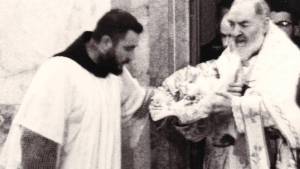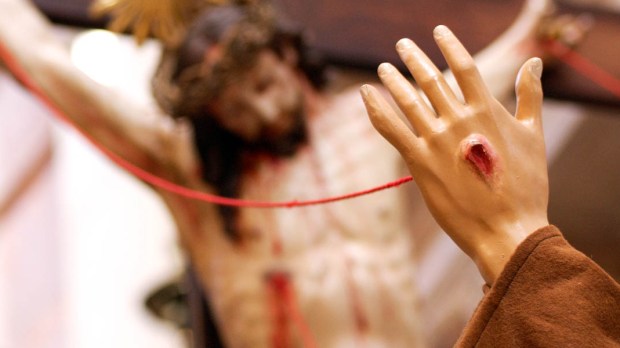When we speak of saints who had the stigmata, we are referring to the miraculous presence of Jesus’ wounds reproduced in the body of the saint. The word is from the Greek for marks made by a pointed instrument.
Many canonized saints through the centuries have received the stigmata. The wounds usually appear visibly on the head (as Jesus’ head was wounded by the crown of thorns) on the hands and feet (as Jesus was wounded with the nails) and on the side (as Jesus was wounded with the lance). Some saints have borne the stigmata invisibly, with the wounds causing pain, but not visible to the outside world.
The Church has always taken due care to examine any claims of the stigmata, and a long list of criteria must be met before Church leaders approve it as a supernatural grace. Saints almost never have asked for such a sign, even though they may have been perfectly willing to bear pain in order to be more like Christ. The stigmata is a unique way for a person to be united to Christ’s suffering while on earth and so draw closer to spiritual perfection.
Here are five holy men and women who were known for their exemplary lives of holiness, and bore the stigmata.
St. Francis of Assisi
One of the earliest persons recorded to receive the stigmata, Francis was marked with the holy wounds of Christ after making a special 40-day retreat on Mount La Verna. At the end of the retreat, Francis saw a winged seraph come toward him and in the midst of the seraph he saw Christ suffering on the cross. Francis’ first biographer, Thomas of Celano, recorded what happened next.
His wrists and feet seemed to be pierced by nails, with the heads of the nails appearing on his wrists and on the upper sides of his feet, the points appearing on the other side. The marks were round on the palm of each hand but elongated on the other side, and small pieces of flesh jutting out from the rest took on the appearance of the nail-ends, bent and driven back. In the same way the marks of nails were impressed on his feet and projected beyond the rest of the flesh. Moreover, his right side had a large wound as if it had been pierced with a spear, and it often bled so that his tunic and trousers were soaked with his sacred blood.
St. Gemma Galgani
An Italian woman who lived from 1878-1903, Gemma had a deep devotion to the Sacred Heart and received a special vision of Jesus. In it, Jesus appeared with his wounds, and fire came down and touched Gemma. This is her account of the experience:
In an instant those flames came and touched my hands, feet and heart. I felt I was dying … then everything vanished and I found myself kneeling on the ground, but still feeling intense pain in my hands, feet and heart. I got up to go to bed and saw blood flowing from those places where I felt the pain. I covered them up as best I could and then, with the help of my guardian angel, got into bed.
The stigmata continued for years up until Gemma’s death, appearing on Thursdays and disappearing on Fridays. After her death, there remained on her body faint marks of where the stigmata had appeared during her life.
St. Catherine of Siena
Catherine was a 14th-century Dominican tertiary who led a deep life of prayer and contemplation. During her life she received the wounds of Christ after receiving Holy Communion, and they were at first visible. However, she petitioned God that the grace be made invisible, so that she could still participate in the suffering of Christ but remain hidden to the world.
She asked this because the visible stigmata, if made public, may attract a cult of followers who, even though well-intentioned, can distract from a person’s mission. God granted her request, and for the rest of her life she bore the hidden stigmata (visible only to herself), suffering interiorly the wounds of Christ. After death the stigmata returned on her body for the world to see.
St. Mariam Baouardy
A Discalced Carmelite who lived from 1846-1878, Mariam experienced the stigmata early on in her life as a religious novice in the convent of the Sisters of St. Joseph of the Apparition. The stigmata occurred every week from Wednesday through Friday. It created problems for her in the convent, as some of the other sisters were skeptical or envious of this favor — especially since the sisters were French, and Mariam, who was of Greek Catholic background and had been born in Galilee, was thought of as “the little Arab.” Mariam would eventually be transferred to a Carmelite monastery, where she made her profession as a nun. Here is her account of the stigmata:
It seemed to me that I was gathering roses to decorate Mary’s altar: these roses appeared to have thorns on both sides, and the thorns were thrust in my hands and into my feet. When I came to myself, my mouth was very bitter, my feet and hands swollen: in the middle of my hands and on my feet there were black bumps.
Her life was filled with other miraculous signs. Mariam Baourdy is a recent saint, canonized on May 17, 2015, by Pope Francis.
St. Rita of Cascia
An Italian nun during the 15th century, Rita did not receive the full stigmata as the other saints did, but as a single thorn embedded in her head. One day a Franciscan priest came to preach in Cascia and St. Rita went to the church to hear him. The topic was the passion and death of Jesus, but what really struck Rita was the crown of thorns that caused Jesus such great suffering. After leaving the church Rita went immediately to a chapel and prayed the following prayer.
Oh my God and crucified Lord! You who were innocent and without sin or crime! You who have suffered so much for love of me! You have suffered arrest, buffeting, insults, a scourging, a crown of thorns, and finally a cruel death on the Cross. Why do You wish that I, Your unworthy servant, who was the cause of Your sufferings and Your pains, should have no share in Your sufferings? Make me, Oh my sweet Jesus, a participant, if not of all of Your Passion, at least of a part of it. Recognizing my indignity and my unworthiness, I do not ask You to imprint on my body, as You did in the hearts of St. Augustine and St. Francis, the wounds that You still preserve as precious rubies in Heaven. I do not ask You to stamp Your holy Cross as You did in the heart of St. Monica. Nor do I ask You to form in my heart the instrumentsof Your Passion, as You did in the heart of my holy sister St. Clare of Montefalco. I only ask You for one of the seventy-two thorns which pierced Your head and caused You so much pain, so that I may feel a part of the pain You felt. Oh my loving Saviour! Do not refuse me this favor. Do not deny me this grace. I will not leave here consoled, if You send me away without so desired a pledge of Your love.
Rita is unique in that she asked Jesus for a portion of the stigmata and her request was answered. A thorn pierced her forehead and left a deep wound that lasted until death. It pained her greatly every day, but she felt more united to Jesus’ suffering and believed it to be a special grace from God.

Read more:
Padre Pio’s secret wound was more painful than the stigmata

